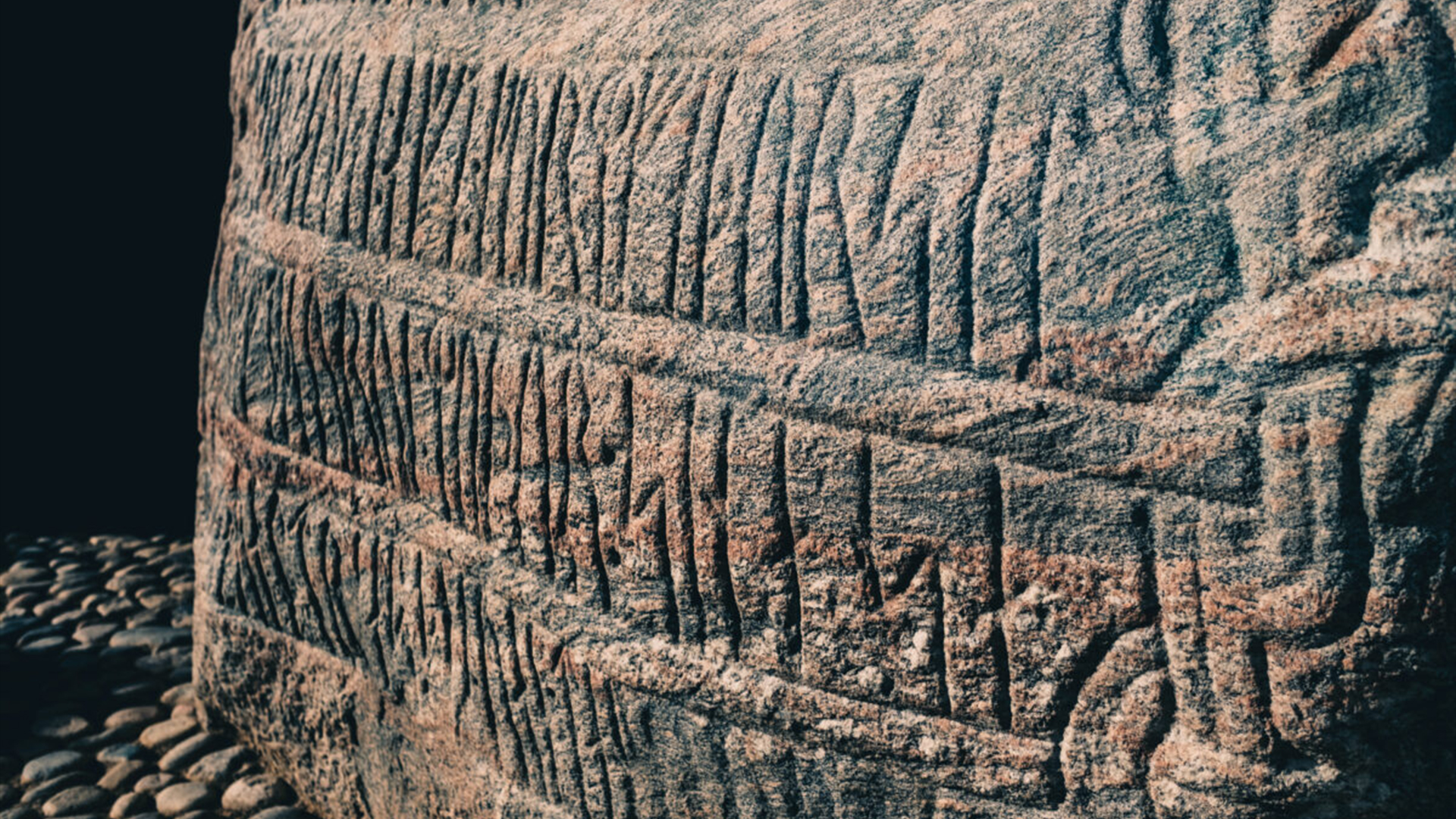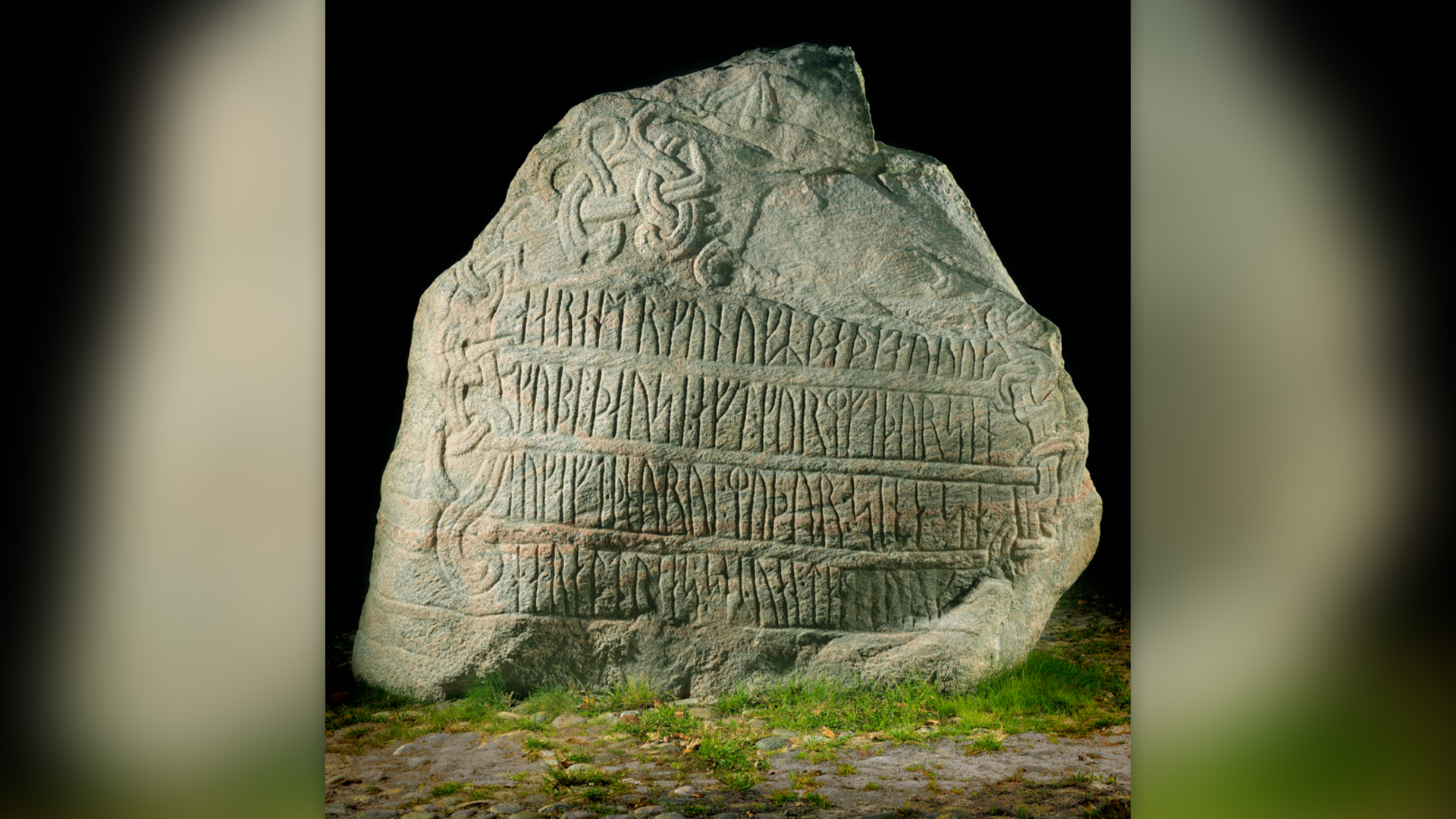Jelling Stone analysis reveals runestone carver's name and identifies a powerful Viking queen
New 3D scans have revealed new information about Denmark's famous Jelling Stone, including the identity of a powerful Viking queen.

Denmark's famous Jelling Stone — which bears the earliest mention of the modern name of the country — is revealing new clues about its creator, a millennium after it was carved. New research suggests the stone, erected around A.D. 965, also shows the immense power of a Viking queen.
The Jelling Stone was commissioned by Danish king Harald Gormsson, better-known today by his nickname, Bluetooth, who successfully unified the country and brought Christianity to the region.
Bluetooth set up a large carved stone in the town of Jelling, placing it alongside an older stone and in between two immense burial mounds. The inscriptions on the stones are made in a runic alphabet, chiseled into lines of horizontal or vertical text. The older, smaller stone was set up by King Gorm, Harald's father, in memory of his wife, Queen Thyra, while Bluetooth set up the larger stone in memory of both Gorm and Thyra.
Related: 1,200-year-old 'Viking graffiti' is the oldest drawing ever discovered in Iceland
Bluetooth's stone carries an inscription on one side trumpeting his achievements as king and celebrating the memory of his mother and father. On the other side, the Jelling Stone includes the oldest Scandinavian depiction of the image of Christ.
The Jelling Stone has been studied for centuries, but for the new research, the team used 3D scanning technology to discover the name of the specific person who carved its runes.
Lisbeth Imer, a runologist at the National Museum of Denmark who led the research, and her team used 3D scans of the stone and others in the region to identify the angle of chisel grooves that created the runes, as well as the distance between them. Assuming that skilled stonemasons typically used the same method of carving runes, Imer and her team identified a "handwriting" signature unique to the rune maker. With this information, they could name the stone's carver: Ravnunge-Tue.
Sign up for the Live Science daily newsletter now
Get the world’s most fascinating discoveries delivered straight to your inbox.
Ravnunge-Tue is known to have carved two stones that mention Thyra. One, found in Læborg, about 23 miles (37 kilometers) southwest of Jelling, bears an inscription that suggests he made it in memory of his queen, Thyra. The other, found in Bække, about 19 miles (30 km) southwest of Jelling, mentions that Ravnunge-Tue and two compatriots made Thyra's burial mound.
But it was not previously clear who carved the unsigned Jelling Stone and whether the Thyra mentioned on it was the same person as the Thyra mentioned on the other stones.
Using a novel method of groove analysis of runestones, the team found Ravnunge-Tue's "signature" carving style was present on the Jelling Stone and on the Læborg Stone, helping to name the Jelling Stone's carver and lending support to the identification of Thyra on the two stones as one and the same: Harald Bluetooth's mother and the wife of Gorm.

Finding Thyra's name on four different runestones, though, suggests she was much more important than someone's wife and mother, as Bluetooth and Gorm are only mentioned on two runestones each. While Gorm is often called Denmark's first king, Imer and her team believe that Thyra likely came from an older, more powerful family in southern Jutland, which leads to new questions about how Denmark was first formed as a nation.
Further information on the team's work is forthcoming in the journal Antiquity and forms the basis of a new Danish documentary series called The Riddle of Thyra.

Kristina Killgrove is a staff writer at Live Science with a focus on archaeology and paleoanthropology news. Her articles have also appeared in venues such as Forbes, Smithsonian, and Mental Floss. Killgrove holds postgraduate degrees in anthropology and classical archaeology and was formerly a university professor and researcher. She has received awards from the Society for American Archaeology and the American Anthropological Association for her science writing.









